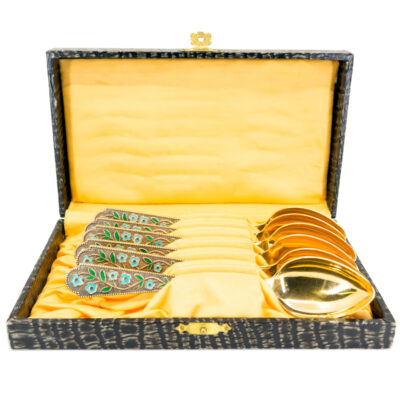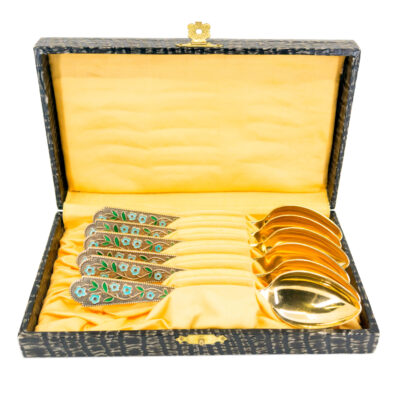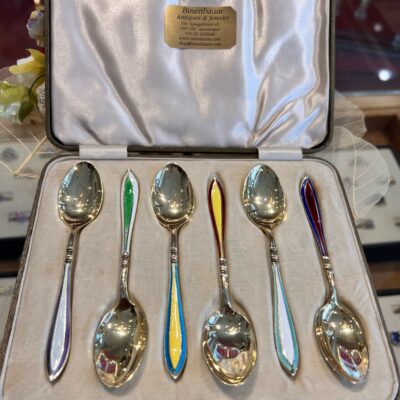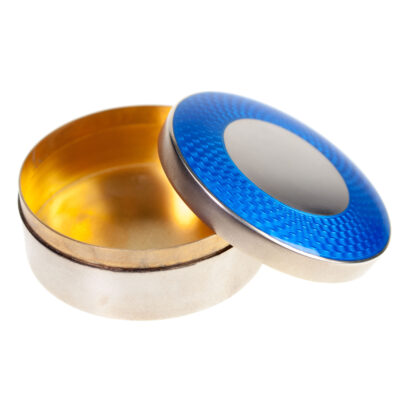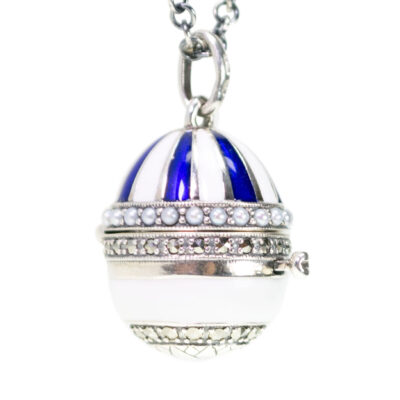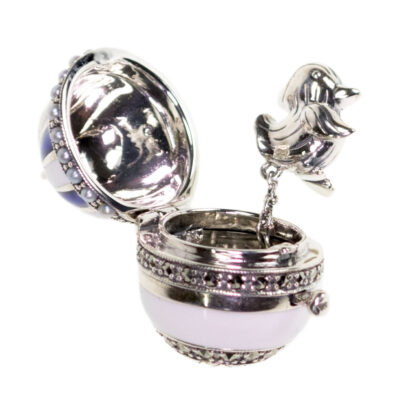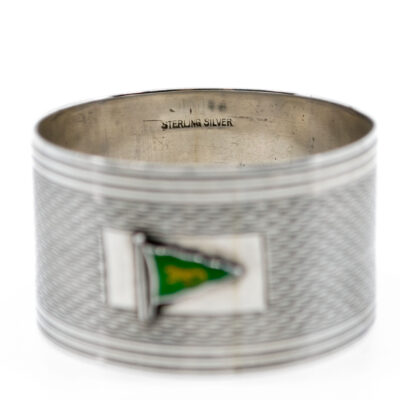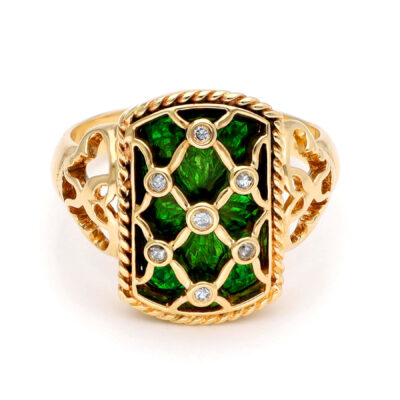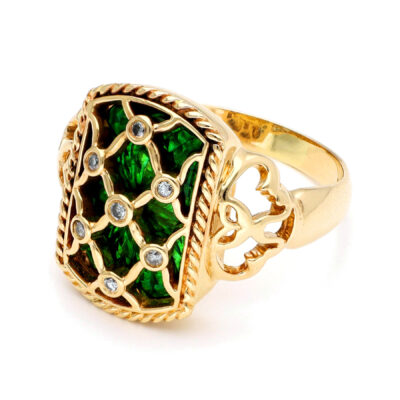This magnificent mid-century (1950-1970) cloisonné spoon set, made in Russia, is crafted in silver-gilt and features enamel. The set includes desert spoons. Cloisonné is a type of decorative art in which enamel is applied to a metal surface in patterns or designs and is separated by thin metal strips, or cloisons.
Videos
This magnificent mid-century (1950-1970) cloisonné spoon set, made in Russia, is crafted in silver-gilt and features enamel. The set includes desert spoons. Cloisonné is a type of decorative art in which enamel is applied to a metal surface in patterns or designs and is separated by thin metal strips, or cloisons.
Details: Enamel, Silver-gilt Spoon Set
Dimensions: L 17.5 x W 4.3 cm.
Weight in grams: 112.
Condition: Very good condition – slightly used with small signs of wear.
| Design Era | |
|---|---|
| Design & Historical Context | The 1950s were a time of great cultural and technological change, marked by the emergence of rock 'n' roll, the birth of the "Beat" Generation, the launch of Sputnik, and the beginning of the space race. These events, and the knowledge that the world was living in a nuclear age, contributed to the development of an aesthetic known as the "Atomic Age," which was reflected in various aspects of design, including jewelry. |
| Key Materials | |
| Materials & Craftsmanship | Enamel: The Artful Fusion of Color and Craftsmanship Enamel is a decorative technique that has been used in jewelry for centuries, known for its ability to bring vibrant color and intricate designs to metal surfaces. Created by fusing powdered glass to metal at high temperatures, enamel can produce a wide range of colors, from bold and opaque to translucent and delicate. Historically, enamel has been used across various cultures, from ancient Egypt and China to Renaissance Europe, to create stunning works of art in jewelry, religious artifacts, and decorative objects. The intricate process of enameling, which requires skill and precision, has made it a prized technique among artisans. In contemporary jewelry, enamel is appreciated for its versatility and ability to enhance the beauty of metalwork. It can be used to add a pop of color to a piece, create detailed imagery, or produce a smooth, glossy finish that complements gemstones and precious metals. Enamel not only adds a burst of color and creativity to jewelry but also represents the craftsmanship and artistry behind each piece. Whether in modern or vintage designs, enamel brings a unique and timeless appeal to jewelry, making it a cherished choice for those who appreciate fine detail and vibrant hues. : The Metal of Elegance and Versatility Silver, known for its bright, reflective luster, is one of the most beloved and widely used precious metals in the world. This versatile metal has been cherished for thousands of years, not only for its beauty but also for its malleability, making it ideal for crafting intricate and delicate jewelry designs. Historically, silver has been associated with the moon and considered a symbol of purity, clarity, and protection. Ancient civilizations, from the Egyptians to the Greeks and Romans, valued silver for its beauty and used it to create coins, jewelry, and religious artifacts. In many cultures, silver is also believed to have healing properties, often used in amulets and talismans to ward off negative energy. In modern jewelry, silver is prized for its affordability, versatility, and timeless appeal. Sterling silver, an alloy of 92.5% pure silver and 7.5% other metals (usually copper), is the standard used in high-quality jewelry. Its durability and bright, reflective surface make it an excellent choice for a wide range of designs, from minimalist pieces to ornate creations. Silver can be polished to a high shine or given a matte, oxidized, or antiqued finish to suit various styles. Silver is more than just a metal; it is a symbol of elegance, flexibility, and understated luxury. Its enduring popularity and wide-ranging applications make it a staple in jewelry that can complement any look, from casual to formal, with timeless grace. Silver-gilt: The Fusion of Luxury and Affordability Silver-gilt, also known as vermeil or gilded silver, is a luxurious yet accessible material that combines the beauty of gold with the affordability of silver. This technique involves coating a base of sterling silver with a thin layer of gold, typically 10k or higher, creating a piece that has the rich, warm appearance of gold while maintaining the strength and durability of silver. Historically, silver-gilt has been used for centuries in the creation of fine jewelry, religious artifacts, and decorative objects. The process of gilding, or applying a gold layer to silver, dates back to ancient times and was especially popular in the Middle Ages and Renaissance periods, where it was used to create elaborate and ornate pieces for royalty and the church. The technique allowed artisans to produce items with the appearance of solid gold at a fraction of the cost. In modern jewelry, silver-gilt is prized for its versatility and elegance. The gold layer provides a luxurious finish that is resistant to tarnish, while the silver base offers durability and a more affordable price point compared to solid gold. Silver-gilt jewelry can range from delicate, minimalist designs to bold, statement pieces, making it suitable for a wide range of styles and occasions. Silver-gilt is often used in rings, necklaces, bracelets, and earrings, where the combination of gold's warmth and silver's strength creates pieces that are both beautiful and long-lasting. The thickness of the gold layer can vary, with vermeil being a specific type of silver-gilt where the gold layer is at least 2.5 microns thick and typically made from higher karat gold. Silver-gilt is more than just a material; it is a blend of luxury and practicality, offering the appearance of gold without the full expense. Its historical significance and enduring appeal make it a popular choice for those who appreciate the beauty of gold and the durability of silver. Whether in classic designs or contemporary pieces, silver-gilt jewelry adds a touch of elegance and sophistication to any collection. |
| Dimensions | L 17.5 x W 4.3 cm |
| Gender | |
| Weight (in grams) | 112 |
| Condition | Very good condition – slightly used with small signs of wear |
By following these tips, you can enjoy your precious jewelry for many years to come.
Related Products
-
Enamel Silver Cloissoné Spoon Set 11790-2853
€ 995,00 VAT incl. (where applicable) -
Enamel Silver-Gilt Deco Spoon Set 8985-2642
€ 795,00 VAT incl. (where applicable) -
Enamel Silver Silver-Gilt Guilloche Box 1427-1904
€ 795,00 VAT incl. (where applicable) -
Enamel Pearl Ruby 925′ Silver Butterfly Brooch 18266-3409
€ 265,00 VAT incl. (where applicable) -
Enamel Marcasite (Pyrite) Pearl 925′ Silver Champlevé Pendant 18271-3414
€ 295,00 VAT incl. (where applicable) -
Enamel Silver Engine Turned Napkin Ring 8181-2569
€ 185,00 VAT incl. (where applicable) -
Diamond Peridot Silver-Gilt Cushion-Shaped Pendant 14611-8380
€ 1.695,00 VAT incl. (where applicable) -
Diamond Enamel 14k “Trellis” Ring 17889-9324
€ 2.595,00 VAT incl. (where applicable)
- Home
- Collection
- Fine Jewelry
- Silver Jewelry
- Silverware
- Boxes
- Candlesticks
- Salt and pepper shakers
- Miniatures
- Salt cellars
- Spoon Set
- Condiments
- Frames
- Napkin Ring
- Spoon
- Oddities
- Cups
- Vases
- Cutlery
- Serving Spoon And Cake Server
- Candlesticks
- Baskets
- Hanukkiah
- Spice Tower
- Yad
- Tea Set
- Sugar Castor
- Napkin Rings
- Wine Bottle Coaster
- Wine Stopper
- Tea Pot
- Jugs
- Rattles
- Hip Flask
- Miscellaneous
- Rings 💍
- About
- Contact






